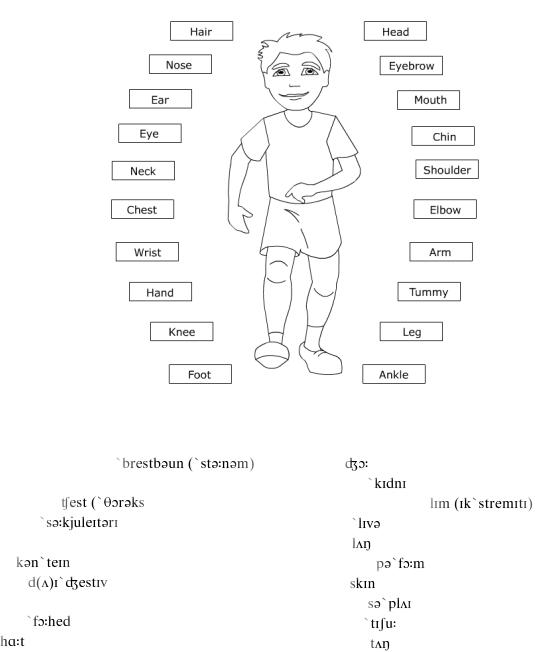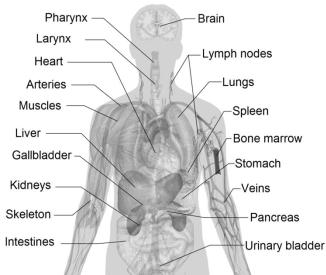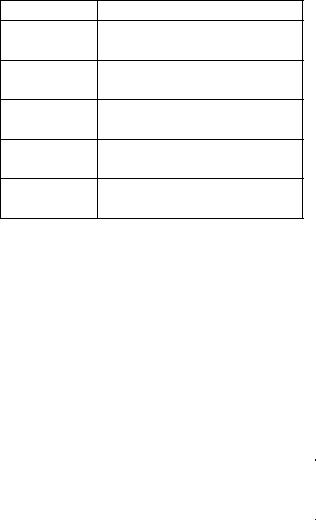
1 курс стомат
.pdfVERNADSKY CRIMEAN FEDERAL UNIVERSITY
L.V. YAGENICH, S.A. LOGVINA, D.V. SHEREMET
ESSENTIAL ENGLISH IN DENTISTRY
PART II
FOR THE FIRST-YEAR STUDENTS
OF THE FACULTY OF DENTISTRY
Simferopol, 2016
L.V. YAGENICH, S.A. LOGVINA, D.V. SHEREMET
Essential English in Dentistry.-Simferopol, 2016
IAD CSMU, 2016.- p.
The manual contains eight thematic units covering the material of the program for dental students of medical higher schools of the Russian Federation.. The manual is designed for first–year students of speciality “Dentistry”. It is also supplied with grammar reference, vocabulary and test questions.
Пособие содержит восемь тематических уроков, охватывающих материал программы для студентовстоматологов медицинских вузов Российской Федерации. Пособие предназначено для студентов первого курса по специальности «Стоматология». Пособие также снабжено грамматическим справочником, словарем и вопросами для зачета.
2
Contents
1. |
Introduction |
5 |
|
|
|
2. |
UNIT 10. Structure of the Human Body |
6 |
|
GRAMMAR: Impersonal Sentences |
|
|
|
|
3. |
UNIT 11. The Skeleton and Bones |
12 |
|
GRAMMAR: Infinitive and Its Functions |
|
|
|
|
4. |
UNIT 12. Muscles |
18 |
|
GRAMMAR: Present Perfect Active |
|
|
|
|
5. |
UNIT 13. The Digestive System |
24 |
|
GRAMMAR: Past and Future Perfect Active |
|
|
|
|
6. |
UNIT 14. Teeth |
30 |
|
GRAMMAR: Relative Sentences |
|
|
|
|
7. |
UNIT 15. The Oral Cavity |
36 |
|
GRAMMAR: One Word Substitutes: One, Ones, That, Those, There, Do |
|
|
|
|
8. |
UNIT 16. The Superior Maxillary Bones |
42 |
|
GRAMMAR: Perfect Passive |
|
|
|
|
9. |
UNIT 17. The Mandible |
48 |
|
GRAMMAR: Indefinite Pronouns |
|
|
|
|
10. |
Grammar Reference |
54 |
|
|
|
11. |
Irregular Verbs |
58 |
|
|
|
12. |
Vocabulary |
61 |
|
|
|
13. |
Table of Tenses |
65 |
|
|
|
14. |
Test Questions |
66 |
|
|
|
3
4
Introduction
Essential English for Medical Students (Part2) is a comprehensive course for students studying English at medical universities. It provides them with the necessary skills to successfully communicate in both oral and written forms of the language.
The second part consists of two submodules in ten units and supplementary material. In total, Essential English for Medical Students (Part 2) is to be covered in 36 hours’ classroom work.
Each submodule ensures coverage of a core of useful language for students of medical faculties of higher schools of the Russian Federation. The units follow the same basic structure outlined below.
Lead-In Sections, containing discussion questions. This is designed as a warm-up activity to the unit. It usually consist s of a number of pictures, and often introduces key vocabulary and concepts. It should be used to get students focus on the topic.
Reading Sections, consisting of one text based on original sources containing key vocabulary of the unit.
Vocabulary Practice Sections, focusing on exploiting the vocabulary introduced in the reading text through various types of exercises such as deduction of the meaning of new words from context, gap-filling, collocations which help students remember vocabulary items as parts of set expressions, word formation, and others.
Language Development Sections are linked to the topic and extend students’ vocabulary at the appropriate level. This is achieved through a variety of lexical exercises, as well as speaking activities related to the topic being discussed.
Grammar in Use Sections presenting grammar structures in detail. These sections are used with the Grammar Reference Section (found at the back of the book) to help students revise the grammar points presented. There is also a wide range of exercises comparing and contrasting different grammar phenomena.
Top Margin containing quotes. These are optional extras and can be used to add variety and interest to your lessons and provide additional material for advanced students who are ‘fast finishers’.
Checklist Sections allowing students to check their own progress.
Key Words Sections including the main items of medical vocabulary introduced in the unit. A translation of each of these words appears in the Vocabulary (at the back of the book).
This section also provides students with the opportunity to personalize the Key words by adding more words or expressions that they think are useful.
Grammar Reference Section being used together with the Grammar in Use Sections as a handy check or revision. It shows the form of a particular grammar point, briefly explains its use, and provides example sentences.
Vocabulary being an alphabetical list of all the Key words and other words which may present difficulty for students.
5

UNIT X. THE HUMAN BODY________________________
In this unit
describing the major parts of the human body
naming the main parts of the trunk, head and limbs
talking about internal organs and organ systems
Impersonal Sentences
Warm-Up Activities
1. Draw a line from each label to the right part of the body:
Parts of the Human Body
2. Memorize the following words you will need in this unit.
breastbone (sternum) / |
/ n |
||
грудина |
|
|
|
chest (thorax) / |
/ n грудная клетка |
||
circulatory / |
/ system сердечно- |
|
|
сосудистая система |
|
||
contain / |
|
/ v содержать |
|
digestive / |
/ system |
|
|
пищеварительная система |
|
||
forehead / |
/ n лоб |
|
|
heart / |
/ n сердце |
|
|
jaw / |
/ n челюсть |
|
|
kidney / |
|
/ n почка |
|
limb (extremity) / |
/ n конечность |
||
liver / |
|
/ n печень |
|
lung / / n лёгкое |
|
||
perform / |
/ v выполнять |
|
|
skin / |
/ n кожа |
|
|
supply / |
/ v доставлять; n снабжение |
||
tissue / |
|
/ n ткань |
|
tongue / |
/ n язык |
|
|
6

Reading
The Parts of the Human Body
All medical students must know the structure of the human body perfectly well.
Human body is a complex system consisting of three principal parts: the head, the trunk and the limbs, or extremities.
The framework of the body is the skeleton which is composed of more than 200 bones of various sizes and shapes. They provide firm but flexible support to soft tissues, muscles and organs.
The skull is composed of 26 cranial and facial bones. The cranial part contains the brain.
The facial bones form the face which consists of the forehead, the eyes, the nose, the mouth, the cheeks, the ears and the chin.
The ear includes three main parts: the external, the middle and the internal ear. The mouth has the upper and the lower lips. There are two jaws with teeth and gums, the tongue and the hard and soft palates in the mouth.
The head is connected with the trunk by the neck. The skeleton of the trunk consists of the spinal column (the spine) and the chest (the ribs and the breastbone).
The trunk is divided into two cavities.
The upper cavity of the trunk (the chest or thorax) contains the heart, the lungs and the esophagus.
The principal organs of the lower (abdominal) cavity are the stomach, the liver, the spleen, the gall-bladder, the kidneys, the urinary bladder and the intestines.
The upper extremities, or limbs, are connected with the chest by the shoulder girdle. Each is divided into the upper arm, the forearm and the hand. Each hand has four fingers and one thumb.
The lower extremities connected with the trunk by the pelvic girdle include the thigh (femur), the leg and the foot. Five digits at the end of the foot are called toes.
The bones of the skeleton are connected together by the joints or by the cartilages and ligaments.
The skeleton is covered with more than 400 muscles. Each has blood and nerve supply as well as a connective tissue framework.
The skin is the thin layer of tissue forming the natural outer covering of the body.
The human body is made up of several organ systems that work together as one unit. An organ system is a collection of organs and tissues working together to perform one major function.
Each system depends on the others, either directly or indirectly, to keep the body functioning normally. Ten major organ systems of the body are the skeletal, the muscular, the circulatory, the nervous, the digestive, the respiratory, the urinary, the endocrine, the integumentary and the reproductive.
Major internal structures of the human body
7

Vocabulary Practice
1.Look at the words in bold type in the above text and explain them.
2.Provide all the possible translations for the following Russian words. Be sure you understand the difference in their meaning:
Russian |
English |
рука
плечо
нога
бедро
палец
3. Match the words to make word combinations:
1. human |
a. lip |
|
|
2. lower |
b. palate |
|
|
3. upper |
c. limb |
|
|
4. hard |
d. bones |
|
|
5. middle |
e. column |
|
|
6. urinary |
f. body |
|
|
7. cranial |
g. tissue |
|
|
8. digestive |
h. bladder |
|
|
9. shoulder |
i. system |
|
|
10. nerve |
j. ear |
|
|
11. connective |
k. girdle |
|
|
12. spinal |
l. supply |
4. Fill in the gaps with the correct word combinations from exercise 3.
1.The liver, the teeth, the pancreas and the tongue are the accessory organs of __________
_________________________________.
2._________________________ connects the upper extremities with the trunk.
3._________________________ is a triangleshaped, hollow organ located in the lower abdomen. It is held in place by ligaments that are attached to other organs and the pelvic bones.
4.The brain is protected from injuries by ______
___________________________________.
5._______________________ is one of the four types of biological tissue that support, connect, or separate different types of tissues and organs in the body.
6._______________________ consists of four groups of vertebrae: cervical, thoracic, sacral ones and the coccyx.
7._____________________ is the only machine in which there are no spare parts. (Hermann M. Biggs)
8.The humerus, the ulna and the radius are bones of __________________________.
9.Otitis media, also known as ______________
infection, is an infection that occurs behind the eardrum, in the middle part of the ear.
5. In English, most adjectives describing anatomical structures are of Latin origin. Provide the corresponding English nouns for the following adjectives. The first one is made for you.
1. the heart |
cardiac |
|
|
2. |
cranial |
|
|
3. |
cutaneous |
|
|
4. |
dental |
|
|
5. |
facial |
|
|
6. |
frontal |
|
|
7. |
gastric |
|
|
8. |
hepatic |
|
|
9. |
labial |
|
|
10. |
lingual |
|
|
11. |
mental |
|
|
12. |
nasal |
|
|
13. |
oral |
|
|
14. |
pulmonary |
|
|
15. |
renal |
|
|
16. |
sternal |
|
|
17. |
thoracic |
|
|
8
Language Development
1. Look through the text about the muscular system and answer the following questions.
1.What are the three principal parts of the human body?
_______________________________________
_______________________________________
______________________________________.
2.What is the skeleton? What does it consist of?
_______________________________________
_______________________________________
______________________________________.
3.What bones constitute the skull? Name the parts of the face.
_______________________________________
_______________________________________
______________________________________.
4.What organs are located inside the mouth?
_______________________________________
_______________________________________
______________________________________.
5.Which cavities is the trunk divided into? List the organs located in each cavity.
_______________________________________
_______________________________________
______________________________________.
6.What are the parts of upper and lower limbs? What do we call digits on hands and feet?
_______________________________________
_______________________________________
______________________________________.
7.Give a definition of an organ system.
_______________________________________
_______________________________________
______________________________________.
8.Name several organ systems of the body and some organs belonging to them.
_______________________________________
_______________________________________
______________________________________.
2. Say whether the following sentences are true (T) or false (F). Correct the false ones:.
1.Another term for the sternum is the chest.____
2.The femur is a part of the lower limb. ____
3.The teeth with the gums, the palates and the toes are located in the mouth. ____
4.The inferior cavity of the chest is the thorax.
____
5.The liver is located in the abdominal cavity.
____
6.The external layer of the human body is formed by the skin. _____
7.The major function of the skeletal system is to support muscles and internal organs. ____
8.There are 20 digits in the human body, namely, eight fingers, two thumbs and ten tongues. ____
3. Which systems do these organs belong to?
The system |
Organs |
|
heart, blood, |
|
arteries |
|
lungs, nose, |
|
trachea |
|
mouth, stomach, |
|
liver, intestines |
|
kidneys, urinary |
|
bladder |
|
skin, hair, nails |
|
|
|
bones, ligaments, |
|
tendons |
|
brain, nerves, |
|
bone marrow |
Now tell about any three organs of the abovementioned using the following description as an example:
The liver is the large, dark-red gland in the upper part of the abdomen on the right side. The liver is an accessory organ of the digestive system. Its main function is to filter blood and to produce bile.
9

5a. Read the text:
Lots of celebrities find fame and fortune because they possess a particularly valuable or desirable body part. There are stories of people who insure their limbs – or other parts – for ridiculously huge sums, because their entire career is based on lovely legs or an exquisite smile. While some body parts are famous in life, others gain renown once they are removed from their famous body. Here is a story of how a body part came to survive the death of its owner.
Einstein’s Brain
Einstein’s brain is perhaps the most famous organ of the 20th century. The brain became synonymous with genius, and remains an item of fascination for neuroscientists. Within hours of
Einstein’s death, his brain was removed for study to try and understand the source of his insights. Several interesting differences between his brain and other people’s were noticed. After the initial study, however, the brain went missing – with no one knowing for certain what had happened to it. Sections of the brain had been given to researchers but the main portions of the brain were still with the doctor who had removed it. The travels of the brain which changed 20th century physics have been documented in several books and films.
5b. Match the underlined words in the text with these meanings:
1.An exceptionally intelligent person __________
2.A facial expression, with the corners of the mouth turned up and the front teeth exposed _________
3.To continue to live or exist ________________
4.A professional who deals with the function of the nervous system and brain ____________________
10
Grammar in Use
Impersonal sentences
Безличные предложения
|
said |
|
the liver is the |
It is |
considered |
|
largest gland in the |
|
thought |
|
body. |
|
|
|
|
|
say |
|
a human skeleton |
They |
consider |
(that) |
was formed more |
|
think |
than one million |
|
|
|
|
years ago. |
|
|
|
the word medicine |
|
says |
|
|
One |
considers |
|
is derived from the |
|
thinks |
|
Latin ars medicina. |
|
|
|
|
Внимание: другие глаголы, которые могут использоваться в безличных предложениях,
включают: to believe (верить, полагать), to assume (предполагать), to suppose
(предполагать), to decide (решать), to discover (выявлять), to expect (ожидать), to know (знать) и некоторые другие. Безличные предложения переводятся на русский язык фразами типа: считают
(считается), говорят, полагают, известно
и т.д.
Безличные предложения используют:
1.Чтобы сообщить о чем-то, в чем вы не уверены:
They say / It is said / One says (that) soon people will live for 150 years.
2.Чтобы совет, который вы даете, звучал менее категорично:
They think / it is thought / One thinks
(that) future dentists should know Anatomy perfectly well.
1. Answer the following questions using the impersonal sentences.
e.g. Who is the best student in your group? (believe) – It is believed that Ruslan is the best student in our group.
1. What should a person do if (s)he has a cold? (think) – It _____________________________
_____________________________________.
